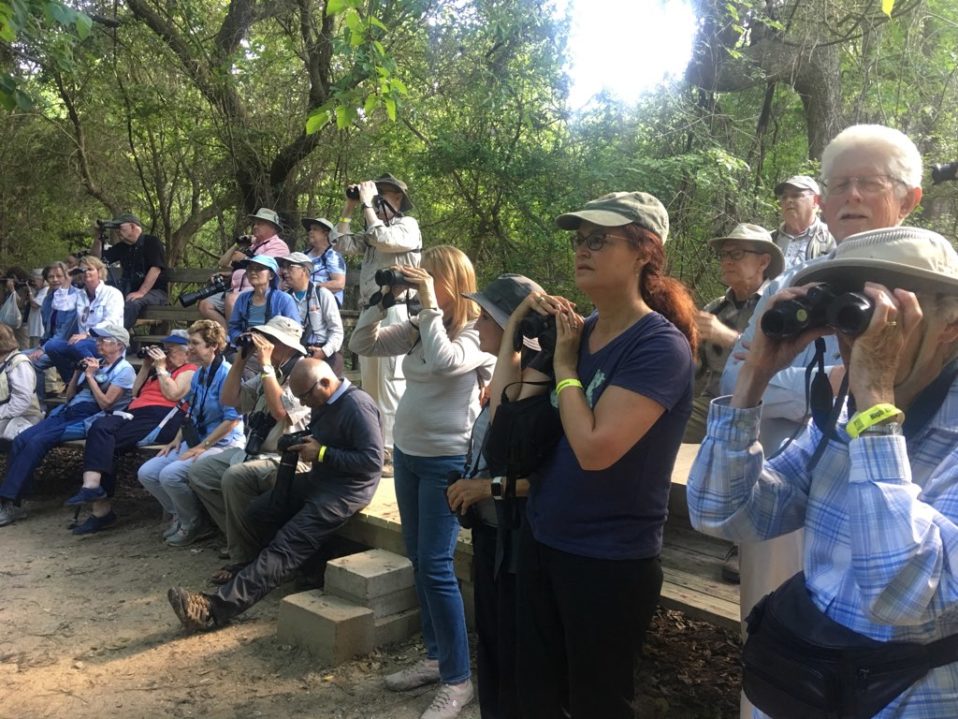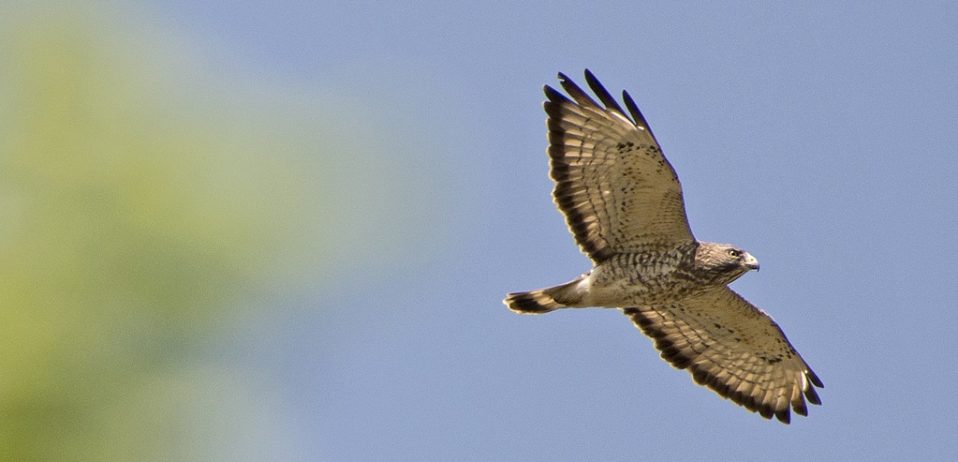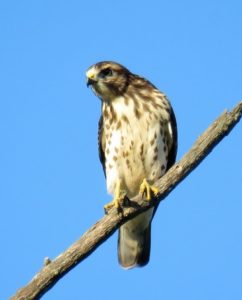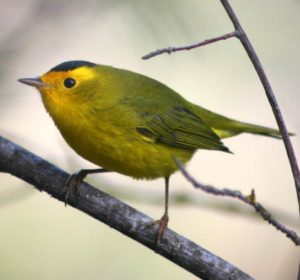Last Friday, April 27, 2019, a group of senior members of the Nature Discovery Center traveled to Anahuac National Wildlife Refuge and High Island for our annual Spring Migration Field Trip, a birding trip we offer during the height of spring migration. The bird list reported here includes species seen in Russ Pitman Park before and after the trip, species seen along the roadsides and at pit stops during the trip, and at the two primary birding destinations. In the photo above, birders are gathered at Boy Scout Woods at High Island.
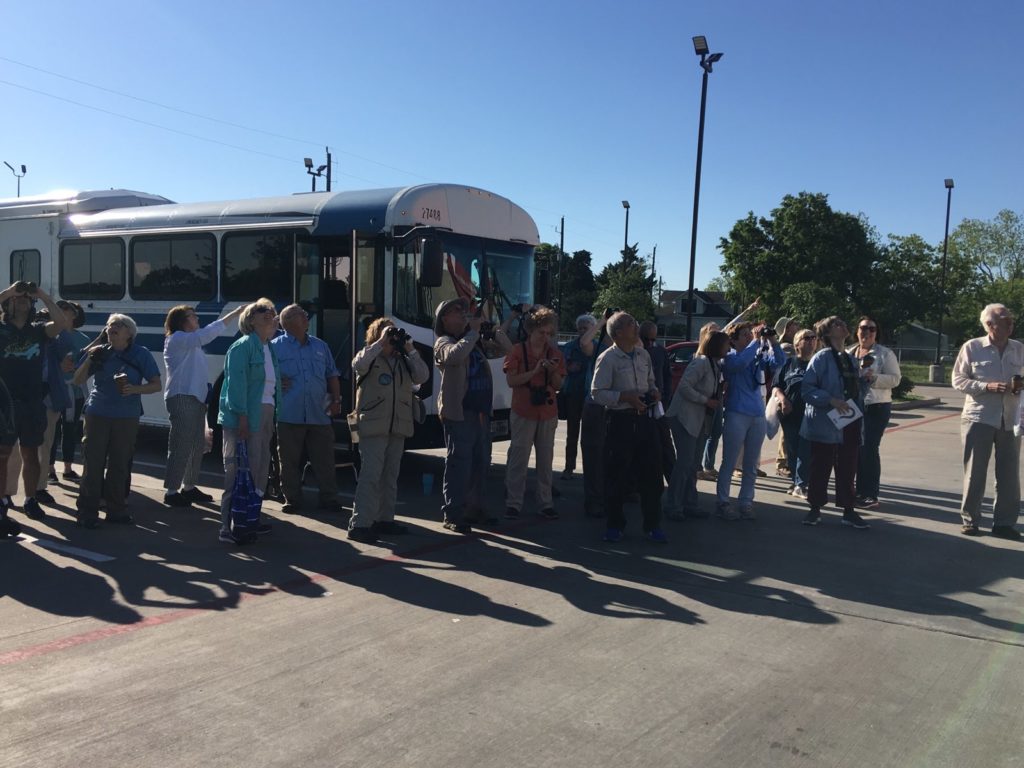
Mary Ann Beauchemin, Senior Naturalist, reports that one of the highlights of the day actually came at a pit stop at a gas station. The group witnessed about 300 Mississippi Kites migrating overhead with some Broad-winged Hawks mixed in!
- Neotropic Cormorant
- Double-crested Cormorant
- Anhinga
- Least Bittern
- Great Blue Heron
- Great Egret
- Snowy Egret
- Little Blue Heron
- Tricolored Heron
- Cattle Egret
- Green Heron
- Yellow-crowned Night Heron
- White Ibis
- Glossy Ibis
- White-faced Ibis
- Roseate Spoonbills
- Black Vulture
- Turkey Vulture
- Black-bellied Whistling Duck
- Fulvous Whistling Duck
- Gadwall
- Mottled Duck
- Blue-winged Teal
- Osprey
- Mississippi Kite
- Cooper’s Hawk
- Red-shouldered Hawk
- Broad-winged Hawk
- Swainson’s Hawk
- Crested Caracara
- Northern Bobwhite Quail
- Purple Gallinule
- Common Moorhen
- American Coot
- Killdeer
- Black-necked Stilt
- Greater Yellowlegs
- Lesser Yellowlegs
- Solitary Sandpiper
- Western Sandpiper
- Long-billed Dowitcher
- Laughing Gull
- Forster’s Tern
- Rock Dove
- White-winged Dove
- Mourning Dove
- Inca Dove
- Yellow-billed Cuckoo
- Eastern Screech Owl
- Common Nighthawk
- Chuck-will’s-widow
- Chimney Swift
- Ruby-throated Hummingbird
- Eastern Wood-Pewee
- Alder Flycatcher
- Great Crested Flycatcher
- Western Kingbird
- Eastern Kingbird
- Scissor-tailed Flycatcher
- Loggerhead Shrike
- White-eyed Vireo
- Blue-headed Vireo
- Warbling Vireo
- Philadelphia Vireo
- Red-eyed Vireo
- Blue Jay
- American Crow
- Purple Martin
- Tree Swallow
- Cliff Swallow
- Barn Swallow
- Ruby-crowned Kinglet
- Blue-gray Gnatcatcher
- Eastern Bluebird
- Gray-cheeked Thrush
- Swainson’s Thrush
- Wood Thrush
- Gray Catbird
- Northern Mockingbird
- European Starling
- Blue-winged Warbler
- Golden-winged Warbler
- Tennessee Warbler
- Northern Parula
- Chestnut-sided Warbler
- Magnolia Warbler
- Black-throated Green Warbler
- Blackburnian Warbler
- Palm Warbler
- Bay-breasted Warbler
- Blackpoll Warbler
- Black-and-white Warbler
- American Redstart
- Prothonotary Warbler
- Worm-eating Warbler
- Northern Waterthrush
- Kentucky Warbler
- Common Yellowthroat
- Hooded Warbler
- Canada Warbler
- Summer Tanager
- Scarlet Tanager
- Northern Cardinal
- Rose-breasted Grosbeak
- Indigo Bunting
- Painted Bunting
- Red-winged Blackbird
- Eastern Meadowlark
- Western Meadowlark
- Common Grackle
- Boat-tailed Grackle
- Great-tailed Grackle
- Brown-headed Cowbird
- Orchard Oriole
- Baltimore Oriole
- House Sparrow
- Cedar Waxwing


